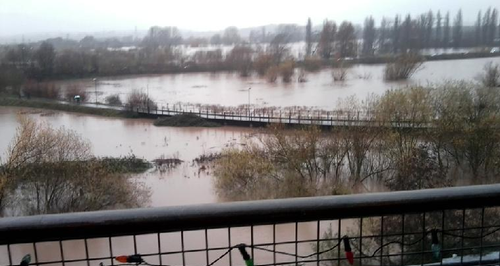Gloucestershire's Flood Risk Management Strategy Approved
5 February 2014, 13:21 | Updated: 5 February 2014, 13:26

The county council’s cabinet has approved the Local Flood Risk Management Strategy for Gloucestershire.
With the devastating effects of flooding on people and communities following the unprecedented flooding in Gloucestershire in 2007, the severe floods in 2012 and now once again with flood alerts currently in place in parts of the county, flood risk is uppermost in many people’s minds. Flooding causes damage to property and infrastructure, and results in significant stress and disruption for people.
The council, which has invested £48 million into flood management and prevention since 2007, has worked with its partners to produce the local strategy, including district councils, water companies, Environment Agency and Internal Drainage Board.
The six key strategic objectives for the local strategy are: to improve our understanding of local flood risk; put in place plans to manage these risks; avoid inappropriate development and ensure new development does not increase flooding elsewhere; increase public awareness of flooding and encourage local communities to take action; ensure close partnership working and co-ordination with other risk management authorities in Gloucestershire, and; support response to, and recovery from, flooding incidents.
Councillor Vernon Smith, cabinet member for highways and flood at Gloucestershire County Council, said:
“It is vital that we work together with organisations and local communities to better understand and manage flood risk. Flooding cannot be wholly prevented, although its impacts can be reduced through investment and good planning.”
Key measures in the strategy include objectives for managing flood risk, increasing understanding of flooding from all sources, how work is funded, resourced and prioritised, and how progress is monitored and reviewed.
The county council has a statutory responsibility for managing flood risk specifically from ordinary water courses, surface runoff and groundwater. This does not mean that the council is solely responsible for managing the risk of flooding in the county though, as, for example, the Environment Agency manages flood risk from the main rivers and the water companies are responsible for the majority of sewers.
The local strategy was subject to public consultation and changes were made following the feedback that was received. In addition, an annual action plan will be produced which will highlight the priority measures and any scheduled flood alleviation work that the county council and partner agencies are carrying out.
Examples of partnership work can currently be seen in Fairford where the county council, Environment Agency, Cotswold District Council and Town Council are jointly funding the town’s flood alleviation work.
The cabinet report and results of the consultation may be viewed online at: www.gloucestershire.gov.uk/localfloodingstrategy.

